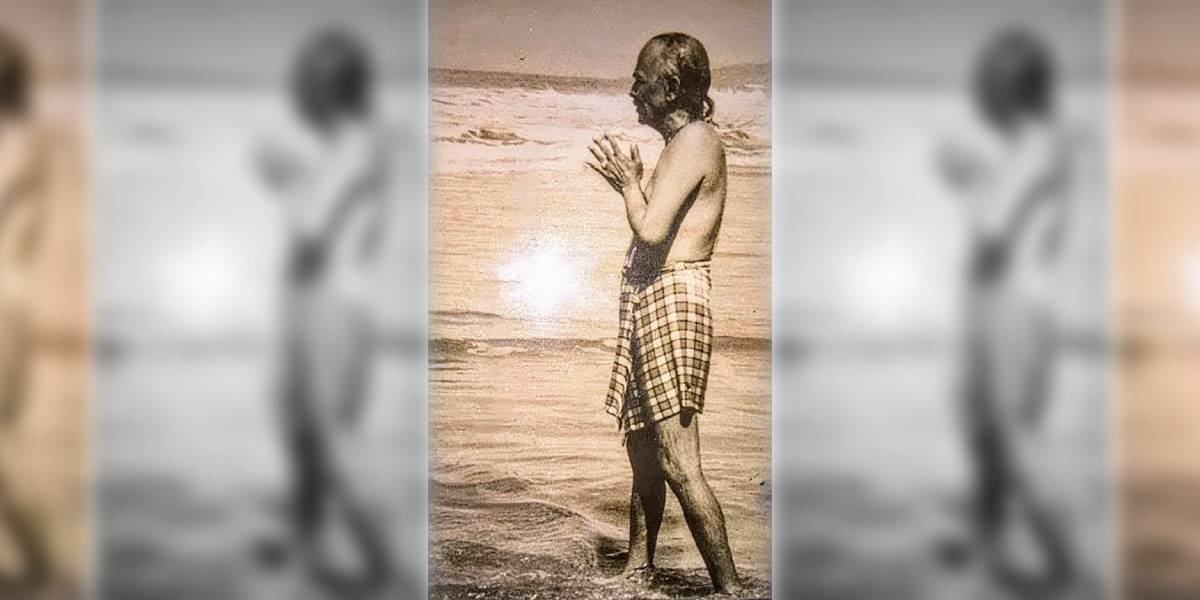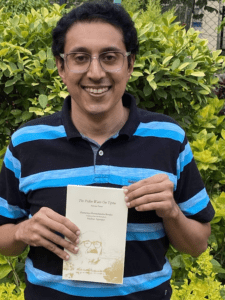Madhav Ajjampur has translated the celebrated Kannada poet's work on his birth anniversary for South First.
Published Jan 31, 2023 | 3:51 PM ⚊ Updated Oct 01, 2024 | 9:22 AM

Madhav Ajjampur first engaged with DR Bendre's Bhaavageeta more than three years ago, when he attempted to translate its famous last stanza (Supplied)
The poem below, titled “ಭಾವಗೀತ (Bhaavageeta)” and first published in DR Bendre’s 1938 “ನಾದಲೀಲೆ (Naadaleele)” collection, can be understood as setting forth his “poetic credo”. As such, it is widely considered one of Bendre’s most important poems.
Imagination’s play came riding in upon the bumblebee,
flapping wings of whetted-air were gaining a natural melody,
a gentle-smile flashed and flew and flashed and flew away —
imagination’s play came riding in upon the bumblebee.
What’s that what’s what? Honey honey! is the obsessive singing sound,
just slightly lesser than the conch-born Om it’s revolving around
in the poet’s mind that like a poem’s plunged in euphonic sound —
imagination’s play came riding in upon the bumblebee.
Like how a spider weaves its web from the thread of its own breast,
like how the brow carves its fate-lines like it itself knows best,
like how life itself leans on its breath to search for its own crest –
imagination’s play came riding in upon the bumblebee.
A still-mute feeling chased itself, going round and round and round,
deep within the womb’s own womb it was making a mantra-sound
fully free, it rose and rose then fell and fell, looking to resound —
imagination’s play came riding in upon the bumblebee.
Everywhere an incense’d been put out for creation’s goddess,
its waves of fragrance became rhythms; the mind-stage turned glorious,
the sprout-tips were becoming buds, love’s blooming was happiness —
imagination’s play came riding in upon the bumblebee.
Its diamond face extended, it was giving the flowers kisses,
sucking nectar it was flying; a moment’s insipidness,
ayyo this pain! aha this death! life’s fruition and fruitlessness —
imagination’s play came riding in upon the bumblebee.
Against the wind its speedy flight was playing touch-and-run,
its crescent-sight was fast crossing the shores of the directions,
with the morning-and-the-evening star it was brightening relations —
imagination’s play came riding in upon the bumblebee.
Like this like that the life-breath’s chord was threading this life’s way,
stood here stood there beauty itself was tapping rhythmically,
“Where’s it come to?” was time’s question as its endlessness held sway —
imagination’s play came riding in upon the bumblebee.
The churn and churning of the word brought forth a euphony,
it felt a joy, it spread a joy, in its own love it was happy,
it did not mean, it did not want, it was just lyric poetry —
imagination’s play came riding in upon the bumblebee.
Imagination’s play came riding in upon the bumblebee,
flapping wings of whetted-air were gaining a natural melody,
a gentle-smile flashed and flew and flashed and flew away —
imagination’s play came riding in upon the bumblebee.
(Translated from the Kannada by Madhav Ajjampur)
As a translator, I first engaged with Bendre’s Bhaavageeta more than three years ago, when I attempted to translate its famous last stanza. While I like to think I succeeded in the attempt, I did not go any further at the time, mostly because I did not believe the rest of the poem could be translated in the same manner. It did not help that the poem contained complex imagery, did not lend itself to easy understanding, and had elicited several different interpretations across the years.
It was a recent request by rasika-sahrudaya Dr. Ashwin Kumar that made me revisit the poem and (re)consider translating some of its other stanzas. (Ashwin requested it in the context of his “free-wheeling meditation” on the poem.)
While I responded to the request with circumspection (I still did not think the entire poem could be translated), the request naturally got me thinking about how I could fit the translation of other stanzas of the poem into the rhyme and metre of the one stanza I had translated.
Turning the original Bendre poem over in my mind, something I hadn’t done in a while, I was in the nearby park in the evening when I worked out a possible translation of the first stanza and typed it out on my ‘Notes’ app so as not to forget it. (What I typed out then was a rudimentary version of what you see above.)

Madhav Ajjampur with ‘The Pollen Waits on Tiptoe’, his English translations of selected poems by DR Bendre (Supplied)
Having taken this first step, I continued to mull over possibilities for some of the more difficult individual lines in the poem. In addition, I also did what I used to do in my early days as a translator: I went over to Mr Sudhindra Deshpande’s blog to see what he had to say about the poem. (A resident of Dharwad, Deshpande, or Sunaath kaaka as I know him, is one of the finest close-readers of and commentators on Bendre’s poetry. His detailed Kannada commentaries on tens of Bendre’s poems were a great help to me when I first took on the challenge of translating Bendre. It is an honour and pleasure to now call Sunaath kaaka a friend and a well-wisher.)
To my surprise, I found that kaaka had written not one but two different explications of Bendre’s Bhaavageeta poem! Written four years apart, it was piquant to note the differences between the two commentaries. I would eventually end up taking some cues from each of the two explications to fashion my own understanding of the poem, which I then used to create the translation you see above.
While I am reasonably satisfied with the translation, I am not accustomed to publicly sharing a translation so soon after its creation. (It has always been my practice to give a translation time to ripen and mature before I share it. That said, I recognise it is virtually impossible to ever say a translation is fully ripe or mature.)
Given this, I would like the reader to look upon this translation as they might a child: as a creature that is both complete in itself and possessing of a capacity for growth and maturation. This may be understood as a variation of what I have said in my book of Bendre translations, namely, “that translation is not an exact science, but, rather, an art constantly seeking an unattainable perfection.”
(Madhav Ajjampur is a writer and translator. He writes for several reasons, the most important being his wish to stay actively engaged with the world around him. His essays, poems, and translations have appeared or are forthcoming in publications including ‘The Hindu’, ‘EKL Review’, ‘Midway Journal’, ‘Kyoto Journal’, and ‘Modern Poetry in Translation’. ‘The Pollen Waits On Tiptoe’ is his first book)
